Research Activities
Research of Fine Arts
The RDAH collects the basic data and resources of traditional fine arts (Paintings, sculptures and crafts) to help researchers in their studies, and to assist the establishment of government policies related to Korea’s cultural assets.
Research on Traditional Paintings
Buddhist paintings have three main purposes: 1) to make temples more beautiful; 2) to facilitate understanding of Buddhist doctrines; and 3) to be used in Buddhist services or ceremonies. Most of the Buddhist paintings that still exist today were painted during the late Joseon Dynasty and are enshrined in Buddhist temples according to the nature of the paintings. A total of 430 Buddhist paintings located in major Buddhist temples were studied from 1976 to 1984 on ten different occasions, and reports titled The Study of Buddhist Paintings Enshrined in Temples Vol. I & II were published in 1989 and 1990.
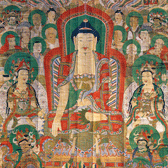
National Treasure, Buddhist Painting of Hwaeomsa Temple
Gwaebul is a type of large Buddhist painting hung up for outdoors rites such as the Buddha's Birthday, the ritual for souls still lingering on earth, and the ritual to pray for rain. It is stored in a box behind the altar in a temple hall. It is reserved for special occasions, when it is hung up in the front courtyard of the temple. Featuring unique iconography, gwaebul provide precious data for research on the history of Korean Buddhist art. Some 53 gwaebul (hanging Buddhist scroll painting) have been studied between 1986 and 2001. Among them, 5 paintings, including Obulhoe Gwaebultaeng (1628) of Chiljangsa Temple, have nee designated as national treasure, while 19 paintings including Yeongsanhoegwaebultaeng (1658) of Cheongnyongsa Temple have been designated as treasure. A series of Gwaebul Investigation ReportⅠ·Ⅱ·Ⅲ (1992·2000·2004) were published.
In 2006, the RDAH, in co-operation with the Cultural Heritage Administration of Korea, undertook a survey of portraits painted during the Joseon Dynasty. After a study of twenty-three portraits of Buddhist monks, the Korean government designated two paintings as national treasures, namely, Portrait of Priest Samyeong (Treasure, in Donghwasa Temple), and Portrait of State Preceptor Doseon (Treasure, in Seonamsa Temple). In 2007, the RDAH hosted a seminar titled Discovery of the World of Portraits in Korea and published the collected papers.
A photo of Survey on Gwaebul
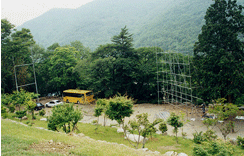 Installation of the gwaebul at Unheungsa Temple
Installation of the gwaebul at Unheungsa Temple
 Installation of scaffold and photography platform at Unheungsa Temple
Installation of scaffold and photography platform at Unheungsa Temple
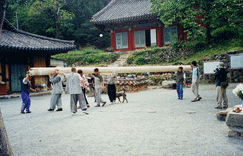 Transportation of the gwaebul Gwaebul at Unheungsa Temple
Transportation of the gwaebul Gwaebul at Unheungsa Temple
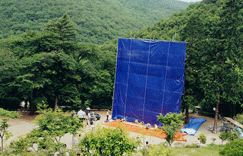 Gwaebul on display at Unheungsa Temple
Gwaebul on display at Unheungsa Temple
 A photo of gwaebul hanging in Unheungsa Temple
A photo of gwaebul hanging in Unheungsa Temple
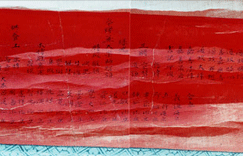 Investigation of painting skills of gwaebul in Unheungsa Temple
Investigation of painting skills of gwaebul in Unheungsa Temple
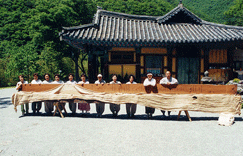 A case for gwaebul in Unheungsa Temple
A case for gwaebul in Unheungsa Temple
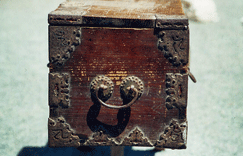 Decoration on the case of gwaebul in Unheungsa Temple
Decoration on the case of gwaebul in Unheungsa Temple
SURVEY OF SCULPTURES
A stupa, or budo, is a small mortuary pagoda housing the bodily remains, or sarira, of a monk. It generally accompanied by a stele bearing the epitaph of the monk to whom it is dedicated. The National Research Institute of Cultural Heritage is carrying out detailed surveys on stupas and stupa steles to determine their precise structural and stylistic characteristics and to accurately date them. Stupas and stupa steles are compared with other temple stone structures and edifices to gather evidence needed for reconstructing the larger picture of Buddhist sculptural trends as well as a social portrait of the period investigated. Under this project, begun in 2002, 22 stupas were surveyed by the year 2006, including the eastern stupa of Yeongoksa Temple (National Treasure). The project is on-going according to an annual rolling plan.
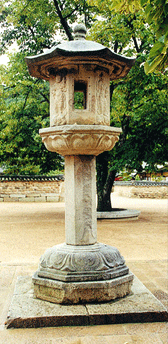
Four Guardian Kings Stone Lantern in Beopjusa Temple (National Treasure)
Stone lanterns were normally erected in front of Buddhist altars or stone pagodas to symbolize the offering of light to Buddha. Along with stone pagodas, stupas, steles, and flagpole supports, stone lanterns are an indispensable part of Korean Buddhist art. The study included twenty-six stone lanterns such as the Sacheonwang Lokapala Stone Lantern at Beopjusa Temple (Treasure) and others designated by the central or regional government. The lanterns are divided into several categories according to their shape of their lantern boxes or pillars including single-pillar, drum-shaped, lion-shaped, human figure-shaped and square-shaped. A total of seventy-four stone lanterns were researched from 1992 to 2001. The lanterns are divided into several categories according to their shape, including drums, lions, human figures and squares. A total of 74 stone lanterns were researched from 1992 to 2001. Research Report on Stone Lanterns Vol. I: Central Shaft Type, and Vol. II: Atypical Type, were published in 1999 and 2001, respectively. The research findings included sculpture techniques, stylistic changes, and architectural investigation based on survey measurements, photos, and rubbings of the carvings.
A photo of Survey on Stone Lanterns
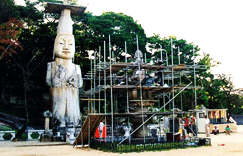 Installation of a Stone Lantern Scaffold at the Gwanchoksa Temple (National Treasure)
Installation of a Stone Lantern Scaffold at the Gwanchoksa Temple (National Treasure)
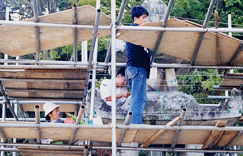 Measurement of the Gwanchoksa Stone Lantern
Measurement of the Gwanchoksa Stone Lantern
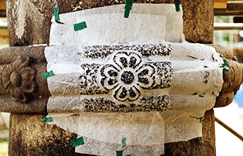 Rubbing of the joint of the Gwanchoksa Stone Lantern Stand
Rubbing of the joint of the Gwanchoksa Stone Lantern Stand
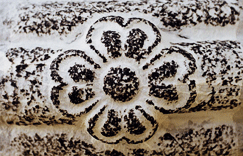 Rubbed Copy of the joint of the Gwanchoksa Stone Lantern Stand
Rubbed Copy of the joint of the Gwanchoksa Stone Lantern Stand
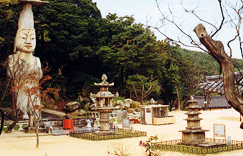 Stone Lantern and Other Stone Structures at the Gwanchoksa Temple
Stone Lantern and Other Stone Structures at the Gwanchoksa Temple
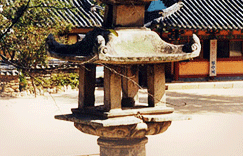 The Stone Lantern of Gwanchoksa Temple
The Stone Lantern of Gwanchoksa Temple
Survey of Craft Works
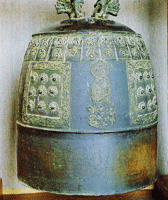
Buddhist Bell at Wontongbojeon Hall of Beopjusa Temple (made in year 50 of Geollyung, 1785)
Buddhist temple bells are ritual instruments sounded to call the community of Buddhists for a meeting or announce the time of day. Under a project that lasted from 1973 to 1976, bells located in Buddhist temples nationwide as well as those in museums and in private collections were surveyed. A total of 159 temple bells, including the Sangwonsa Temple Bell (National Treasure), were closely examined. Rubbings and photos of these temple bells were then compiled into a book titled Buddhist Temple Bells of Korea (Hangukui Beomjong), which was published in 1996. This was followed in 1999 by another publication titled Goryeo Buddhist Temple Bell Donated by Himiko Takahara (Takahara Himiko Gijeung Goryeo Beomjong), which investigates a temple bell presumed to be from the pavilion Naksujeong, which was
taken to Japan and later donated back to the Korean government by a Japanese collector named Himiko Takahara. The bell has been analyzed and treated by conservation science specialists. As for the book, it contains drawings of this temple, based on actual measurements and rubbings of the surface motifs. This temple bell has been designated Treasure under the name Goryeo Temple Bell from Naksujeong and is currently on display at Jeonju National Museum.
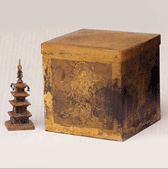
Complete set of remains discovered in the five-story stone pagoda of Nawon-ri
A sarira reliquary (sari jangeomgu) refers to all the receptacles and apparatus involved in enshrining the sarira of Buddha or a respected monk inside a stupa or pagoda. Sarira reliquaries discovered in the process of disassembling a stone pagoda are taken from the sarira niche for study and preservation. The utensils undergo scientific analysis, and analysis he perspective of art history and architecture history, and sarira-associated faith. In 1998, the institute published a report on the sarira reliquary discovered inside the five-story stone pagoda of Nawon-ri in Gyeongju (National Treasure), and another in 2000, on the sarira reliquary discovered inside the eastern three-story pagoda at Gameunsa Temple Site (National Treasure), during its disassembly. The institute will continue its research on artifacts discovered from stupas and pagodas during disassembly.
Research Accomplishments
| 1989 | Buddhist Paintings from Temples of Korea I: Gyeonggi-do, Gangwon-do, Chungcheongnam-do and Chungcheongbuk-do (Sachal Sojang Bulhwa Josa I: Gyeonggi-do, Gangwon-do, Chungcheongnam-do, Chungcheongbuk-do Pyeon) |
|---|---|
| 1990 | Buddhist Paintings from Temples of Korea II: Busan, Gyeongsangnam-do, Gyeongsangbuk-do, Jeollanam-do and Jeollabuk-do (Sachal Sojang Bulhwa Josa II: Busan, Gyeongsangnam-do, Gyeongsangbuk-do, Jeollanam-do, Jeollabuk-do Pyeon) |
| 1992 | Report on Buddhist Gwaebul Paintings I (Gwaebul Josa Bogoseo I) |
| 2000 | Report on Buddhist Gwaebul Paintings II (Gwaebul Josa Bogoseo II) |
| 2004 | Report on Buddhist Gwaebul Paintings III (Gwaebul Josa Bogoseo III) |
| 2001 | Report on Stone Lanterns II: Atypical Type (Seokdeung Josa Bogoseo Je 2 Jip: Ihyeongsik-pyeon) |
| 1995 | Buddhist Temple Bells of Korea (Hangukui Beomjong) |
| 2000 | Goryeo Buddhist Temple Bell Donated by Himiko Takahara (Takahara Himiko Gijeung Goryeo Beomjong) |
| 1998 | Sarira Reliquary from the Five-story Stone Pagoda of Nawon-ri, Gyeongju (Gyeongju Nawon-ri Ocheung Seoktap Sari Jangeom) |
| 2000 | Sarira Reliquary from the Eastern Three-Story Stone Pagoda of Gameunsa Temple Site (Gameunsaji Dong-Samcheung Seoktap Sari Jangeom) |
| 2004 | Survey Report on Joseon Stone Sculptures and Structures in the Collection of the Kyoto National Museum (Ilbon Gyeongdo Gungnip Bangmulgwan Joseon Seongmul Josa Bogoseo) |
Research on Historical Sites of Namsan Mountain in Gyeongju
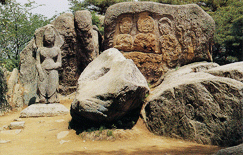 Southern view of the remains of temple site #1 at Namsan Mountain, Gyeongju
Southern view of the remains of temple site #1 at Namsan Mountain, Gyeongju
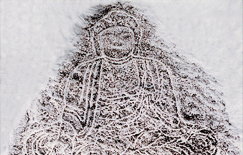 Rubbing of the Rock-carved Seated Buddha, Namsan Mountain, Gyeongju
Rubbing of the Rock-carved Seated Buddha, Namsan Mountain, Gyeongju
Research was carried out on Namsan Mountain in Gyeongju and three reports including illustrations and photos were published for the purpose of establishing a database of the Buddhist culture of the Silla Kingdom.From 1982 to 1986, pagodas in ancient temple sites were surveyed and a research report titled Buddhist Relics of Namsan Mountain in Gyeongju: A Study of Pagodas and Pagoda Remains was published in 1992. From 1987 to 1995, a total of 123 temple sites located in the eastern and western parts of Namsan Mountain were studied and research papers titled Buddhist Relics of Namsan Mountain in Gyeongju: A Study of the West Namsan Temple Sites and Buddhist Relics of Namsan Mountain in Gyeongju: A Study of the East Namsan Temple Sites were published in 1998 and 1999 respectively. The research papers included studies of related historical documents, temple layout and scale.
Research Results
| 1992 | GBuddhist Archaeological Sites and Monuments in Namsan of Gyeongju : A Survey Report on Pagodas and Pagoda Remains (Gyeongju Namsan-ui Bulgyo Yujeok: Tap-mit Tapjae Josa Bogoseo) |
|---|---|
| 1992 | Archaeological Sites and Monuments in Namsan of Gyeongju I (Gyeongju Namsan-ui Bulgyo Yujeok I) |
| 1997 | Archaeological Sites and Monuments in Namsan of Gyeongju II (Gyeongju Namsan-ui Bulgyo Yujeok II) |
| 2000 | Archaeological Sites and Monuments in Namsan of Gyeongju III (Gyeongju Namsan-ui Bulgyo Yujeok III) |
Project to Publish The Dictionary of Korean Painters
The project to publish The Dictionary of Korean Painters took five years (from 2007 to 2011) and included the biographies and art works of all the painters, calligraphers, and Buddhist monks since the building of the Korean nation began in 1945. Two volumes of The Dictionary of Korean Painters, covering 2,260 painters and including color prints of some of their works, were published in 2011. It is hoped that with this book, the Korean public will derive greater knowledge and understanding of the history of Korean fine arts and so be able to share in the results of the research.


